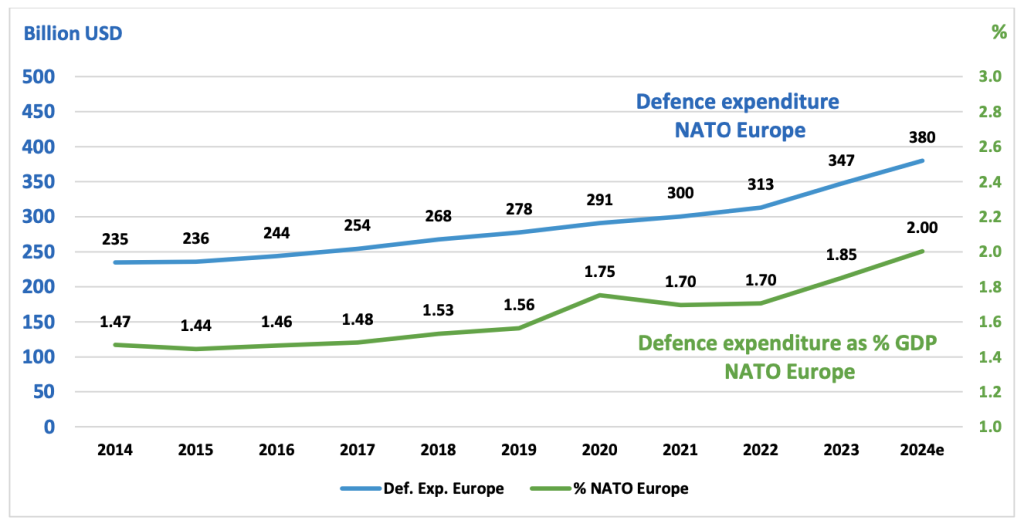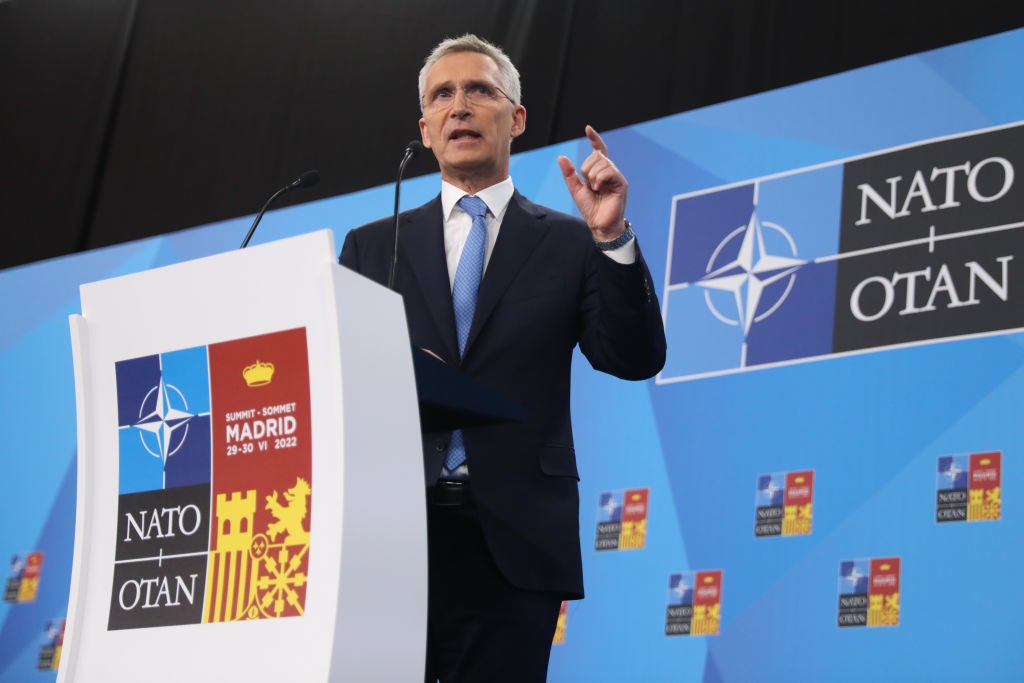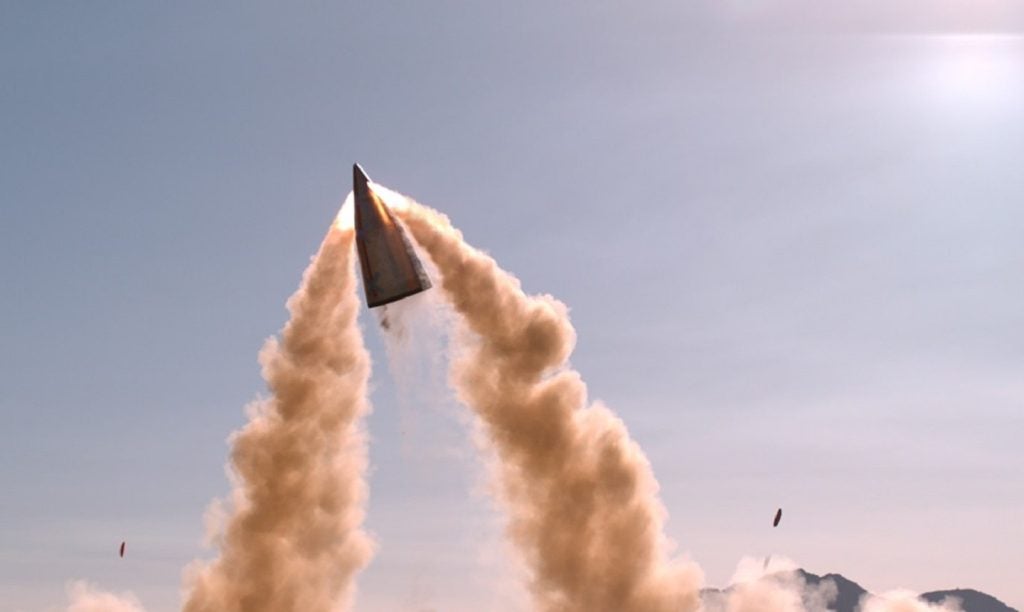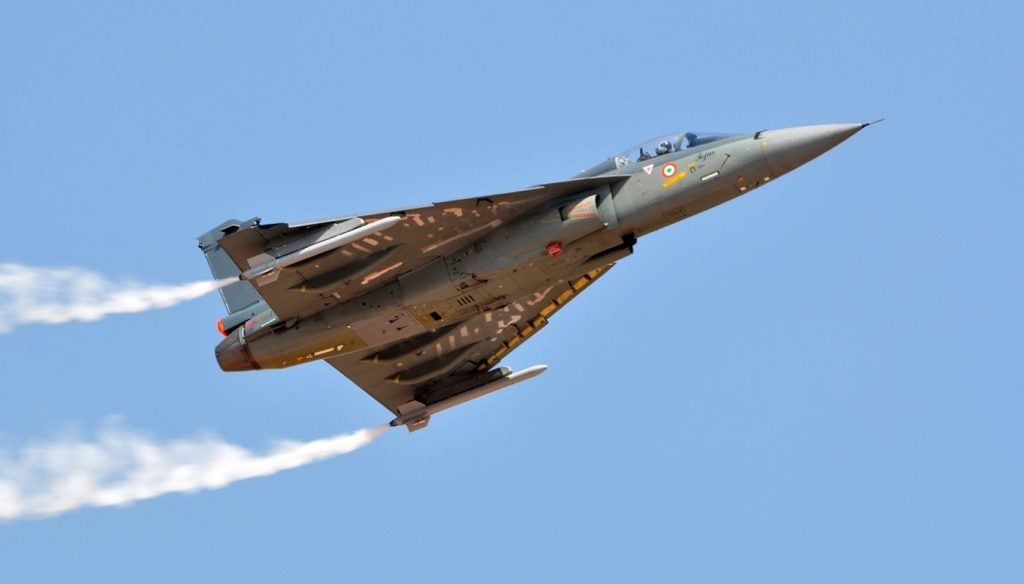The year 2024 will be the first time that European Nato Allies spend 2% of their combined GDP on defence expenditure, according to Nato’s latest figures, released on 15 January, 2024.
Nato Secretary General Jens Stoltenberg welcomed the news in advance of the meeting of Defence Ministers, remarking on the “unprecedented rise”. The advance in spending still to come builds on the 11% increase in defence spending across Europe and Canada across 2023, a year when 18 individual countries spent in excess of 2% of their GDP on defence projects.
Defence expenditure has been growing annually since the original commitment to a 2% target was agreed in 2014, but until the full-scale invasion of Ukraine in 2022 this increase had hovered around a $10bn (€9.3bn) per year increase.
2024 is set to mark the second successive year with an increase in spending on defence of more than $30bn by European countries, going from $313bn in 2022, to $347bn in 2023, to $380bn in 2024.
“In 2024, NATO Allies in Europe will invest a combined total of 380bn US dollars in defence. For the first time, this amounts to 2% of their combined GDP," said Mr Stoltenberg in remarks on 15 February.
“We are making real progress: European Allies are spending more,” added Stoltenberg. “However, some Allies still have a ways to go. Because we agreed at the Vilnius Summit that all Allies should invest 2%, and that 2% is a minimum.”
In the two years since Russian troops crossed the border and headed towards Kyiv, countries around the world have set record defence budgets.
In the indo-pacific region, many of these increases can be seen as a response to increased tensions over territorial disputes with China.
The increase in defence spending by European Nato Allies is instead viewed as a direct response to aggression by Russia against Ukraine and its full scale invasion of the country beginning in February 2022.

Of countries in Europe that increased their defence spending most profoundly in 2023, Poland ranks highest, with a single year increase in 2023 of $12.5bn, up to $29.1bn, from $16.6bn in 2022.
Germany follows Poland, with an increase in its defence spending of $7.3bn in 2023, up to $68bn, from $60.8bn in 2022.
Using current prices and exchange rates, only two countries saw a drop in their defence spending in 2023, the UK and Greece. Greece lowered its defence spending by $1.4bn, and the UK lowered its spending by $889m.
However, as a percentage of GDP, both countries spent above 2% on defence spending on defence expenditure, with the UK spending 2.07%, and Greece spending 3.01%, based on 2015 prices.
The spending announcement from Nato followed five days after a campaign rally for former US President Donald Trump, on 10 February, where the leading Republican primary candidate caused uproar with statements about a potential withdrawal of US support for the alliance under a second Trump administration.
Trump stated that Nato allied countries that failed to meet their 2% GDP defence expenditure would not receive support from the United States under the collective defence agreement in Article 5 of the North Atlantic Treaty that underpins the Nato alliance.

He went on to say that as President of the United States, in respect to any country that did not “pay its bills”, he would encourage Russia to “do whatever the hell they want.”
These remarks were widely criticised as being unhelpful, as the overall deterrent effect of Article 5 against aggression rests in maintaining the belief among Nato’s potential adversaries, that an attack against one Nato Ally would be treated as an attack against all Nato Allied countries.
Outside of Nato, the US has many bilateral and multilateral security agreements with partners across the world, and observers have questioned if, in every case, the United States would manifest the political will to adhere to its obligations. The extension of the US 'nuclear umbrella' is a key example, with doubts surrounding the will to enter nuclear war following a first strike against a partner country.
However, to posture in a way that suggests a security alliance and then to fail in the enactment of such duties mandated by the security treaty would at least provide a deterrent against aggression, up to the point at which it is tested. To publicly suggest that the United States would not, under a Trump presidency, support its Nato Allies limits the effectiveness of a deterrent posture for all member nations.
Arguments that Trump’s demands for Allied nations increase defence spending during his time in office have been successful are not supported in an observation of spending patterns, with the largest increases in total defence spending by European Nato Allies coming after his his time in office.
The only time that Nato’s Article 5 has been invoked has been in 2001, when America called on its Nato Allies following the September 11 terrorist attacks, resulting in an assertive response from allied nations.
Trump’s characterisation of the defence spending target as a “bill” is also misleading. The intention is to encourage countries to spend a specific proportion of their national income on defence programs without specifying the origin of this procurement. There is no obligation to receive foreign military sales from the United States, nor any associated debt without the provision of material.
The spending target agreed in Wales in 2014 was also mischaracterised by Tump. Put forward as an aspirational goal, Allied-countries were meant to “aim to move towards the 2% guideline within a decade”. In 2014, Nato Allies in Europe invested 1.47% of their collective GDP in defence, while the recently announced spending plan data indicating the group is in closer proximity towards the 2% target than in any prior year.












